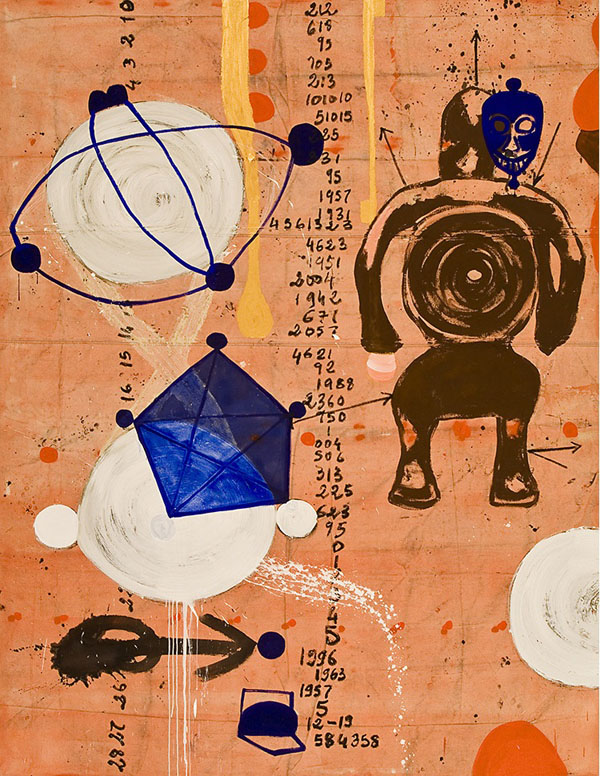Glenn O’Brien tells of magic and science in the paintings by Ouattara Watts
Following my post about the exhibition by Ouattara Watts in New York, I received a very pleasant surprise: an unpublished text by the great journalist and art critic Glenn O’Brien, dedicated to Ouattara.
An entire volume would be needed to explain who Glenn is: those who are curious can go and read his profile on Wikipedia, I suggest contemporary art lovers go straight to read his text, which, as usual, is very interesting.
OUATTARA WATTS presented by Vladimir Restoin Roitfeld, New York City
Jean-Michel Basquiat met Ouattara in Paris in 1988 when Basquiat was there for an exhibition. Ouattara, born in Cote d’Ivoire, was thirty one, Basquiat born in Brooklyn, son of a Haitian father and Puerto Rican mother, was 27. They were kindred spirits who hit it off immediately. Both men had a princely attitude and the sensibility of a magician, not to mention a gift for painting.
Basquiat convinced Ouattara to come to America, and he arrived in New York in April and they travelled together to New Orleans to attend the city’s famous jazz festival. Basquiat had an exhibition at the Vrej Baghoumian Gallery at the end of the month, which proved to be his last. Although he was plagued with doubts because of criticism in the press, disputes with friends, family, dealers, and others, and he was having difficulties with drugs, he managed to create an extraordinarily powerful exhibition of large, spare, haunting paintings.
After the turmoil that went into the show, the dinner after at Mr.Chow’s restaurant was a triumph. That’s where I met Ouattara, with whom Basquiat was planning his second visit to Africa in the summer. On his first visit Jean-Michel had, coincidentally, visited Ouattara’s home town Korhogo in Cote d’Ivoire. But first Basquiat travelled to Maui to restore himself to health.
He returned to New York and purchased tickets for Abidjan, the port city of Cote d’Ivoire, but six days before their departure Basquiat died of a drug overdose in his studio on Great Jones Street in New York City. Basquiat’s dealer Vrej Baghoumian mounted a large retrospective show shortly afterward, and that’s when I saw Outtara again, and we bonded, toasted our good friend and his extraordinary work.
Ouattara settled down in New York, opened up a studio and began painting. You could see the Basquiat affinity and influence but Ouattara was clearly his own man, and the work directly connected West African aesthetics with modernism. You saw tendencies toward what was called neo-expressionism (when they tried to make a movement out of Salle, Schnable, Basquiat, and the young Germans) colliding with African graphic tradition. In 1992 he mounted a large show at Basquiat’s last gallery, Baghoumian, and in short order showed in Paris, Los Angeles, Rome, Milan and Japan, and at such galleries as Gagosian and Leo Koenig.
A family man who is as accomplished in the art of living as in art, Ouattara never seemed in a particular hurry. Over the years I visited his studio and always saw interesting complex work, but he never seemed out to make a big splash. He was almost shy and modest, even though he clearly believed in his work.
Two years ago I was wandering through the Miami Basel art fair when I spotted a painting from far off that drew me in. Getting close I realized it was a magnificent painting by my old friend Ouattara. I think some of us develop our powers over a longer period of time, while some, like Basquiat, are skyrockets. It’s not really about work, but an approach to life. I find that Ouattara has developed a wonderful mature style that has real power and depth. Not a shooting star but a rising sun.
In early February the astute young dealer Vladimir Restoin Roitfeld staged a large Ouattara exhibition in a huge warehouse space in Soho—all large canvases, mostly in bright and earth colors with elements of collage and mixed media. The paintings seem to depict scientific formulas, magic spells, astrological arcana, and mystical mathematics. Imagine the notebooks of Galileo or Leonardo transcribed by a Haitian houngan. Imagine a place where voodoo and the divine pantheon of Africa connects with poetry, astronomy and speculative physics.
All art worthy of the name is magic and conjuring and Ouattara has finally achieved mastery in its practice, uniting ancient lore with the bold techniques of modernism.
“Ouattara Watts: Vertigo,” Feb. 7-20, 2012, at 560 Washington Street, door 37E, New York, N.Y. 10014
Glenn O’Brien
